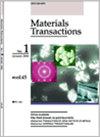基于人工神经网络和遗传算法的粉末成形过程中粉末粒度分布的元启发式优化
IF 1.9
4区 材料科学
Q4 MATERIALS SCIENCE, MULTIDISCIPLINARY
引用次数: 0
摘要
提出了一种基于神经网络的粉末成形过程最大轴向应力最小化方法。利用MATLAB代码和ABAQUS python脚本进行有限元分析,生成神经网络训练过程的观测值。将三种不同粒度分布的粉体进行混合,以混合分数为控制参数。人工神经网络确定了参数与目标函数之间的关系。分析了混合料组分对最大轴向应力的影响。结果表明,遗传算法能有效地确定最优点,该方法具有较强的预测能力和准确性。本文章由计算机程序翻译,如有差异,请以英文原文为准。
Metaheuristic Optimization of Powder Size Distribution in Powder Forming Process Using Multi-Particle Finite Element Method Coupled with Artificial Neural Network and Genetic Algorithm
A neural network-based approach is proposed to minimize the maximum axial stress in the powder forming process. The finite element analysis was conducted using a MATLAB code and an ABAQUS python script to generate observations for the neural network training procedure. Powders of three different particle size distributions were mixed, and the mixture fractions were considered as control parameters. The artificial neural network determined the relationship between parameters and objective function. The effect of mixture fractions on maximum axial stress was analyzed. The results showed that the genetic algorithm could effectively determine the optima and the proposed method had strong prediction capability and accuracy.
求助全文
通过发布文献求助,成功后即可免费获取论文全文。
去求助
来源期刊

Materials Transactions
工程技术-材料科学:综合
CiteScore
2.00
自引率
25.00%
发文量
205
审稿时长
2.7 months
期刊介绍:
Information not localized
 求助内容:
求助内容: 应助结果提醒方式:
应助结果提醒方式:


